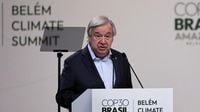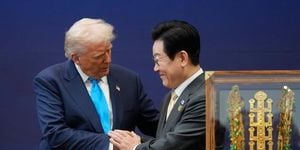As world leaders descend on Belém, Brazil, for the 30th United Nations climate summit—COP30—there’s a palpable sense of urgency in the air. For many, this gathering is more than a diplomatic ritual; it’s a reckoning. Thirty-three years after Brazil hosted the Rio Earth Summit, where the foundational UNFCCC treaty was signed, the country is once again at the center of global climate action. Yet, beneath the speeches and pledges, a quieter story of resilience and frustration plays out in the margins—one that’s all too often overlooked.
At the heart of this year’s summit is the question of money: who pays, how much, and—most crucially—who actually receives it. According to India Today, COP29 in Baku last year saw developed nations agree to provide at least $300 billion annually by 2035 to help developing countries tackle and adapt to climate change. This new promise, called the New Collective Quantified Goal (NCQG), replaced the old $100 billion target that was never fully met. The summit also unveiled the “Baku to Belem Roadmap,” aiming to scale total climate finance from both public and private sources to a staggering $1.3 trillion a year by 2035. The United Nations Conference on Trade and Development (UNCTAD) called it a “turning point,” finally acknowledging the scale of what developing nations need to face the climate crisis.
But for those on the frontlines—especially women leading grassroots climate action—these headline numbers ring hollow. As Mela Chiponda, a gender-justice expert from Zimbabwe, wrote in PassBlue just before COP30 opened, less than 1 percent of global climate finance actually reaches frontline women-led communities. Even more stark: only 0.2 percent of foundation funding supports women’s environmental projects. Billions may be pledged in conference halls, but the women rebuilding homes, caring for families, and replanting fields after disaster often see almost nothing.
Chiponda’s firsthand experience is telling. After Cyclone Freddy devastated Malawi in 2023, it was women who walked for miles through debris to search for the missing and feed the hungry. In Zimbabwe, following Cyclone Idai in 2019, women came together to offer psychosocial support, organize care for children, and keep communities from collapsing—often with no resources, shelter, or health facilities. International aid took more than two weeks to arrive in the hills of Chimanimani, and only soldiers were rescuing people. Yet local women, with a handful of activists, became the caregivers who saved lives, sharing what little they had while their own safety and well-being hung in the balance.
“This altruism was driven not by funding or recognition, but by love, solidarity and the unbreakable bonds of sisterhood,” Chiponda wrote. “Amid unimaginable loss, when communities have felt abandoned and invisible, other women activists have stood in the storm with them, their lives becoming both shield and lifeline for women who refused to be forgotten.”
These women are not outside consultants or distant NGOs—they’re farmers, caregivers, organizers, and leaders holding their communities together when everything else falls apart. They organize themselves, pooling resources and stretching a few dollars to meet the needs of entire villages. Yet, as Chiponda notes, they remain invisible to global climate funding systems like the Green Climate Fund, the Global Environment Facility, or the Adaptation Fund. Large international organizations receive millions from donor governments and foundations, but much of it is spent on overhead, bureaucracy, and institutional growth. Patriarchy is deeply rooted in these institutions, determining who sits at the decision-making table and who gets credit for climate solutions.
“It is no coincidence that the women doing the hardest, most lifesaving work are the least funded,” Chiponda argued. And this is why new funding models are desperately needed.
Enter the Jane Fonda Gender and Climate Justice Fund. Created to correct this imbalance, the fund moves money directly to women-led frontline groups in Ecuador, Indonesia, Nigeria, and Senegal—bypassing layers of international bureaucracy. As PassBlue reported, one of the fund’s grantees is Ceibo Alliance in Ecuador, which unites Indigenous nations to defend their territories from oil and mining extraction and build Indigenous-led environmental justice solutions. The fund, named after longtime activist Jane Fonda, represents a new kind of climate response, rooted in trust and redistribution. “It recognizes that women on the frontlines do not need rescuing but resourcing,” Chiponda emphasized.
The stakes are high. Climate change is widening the gender gap and erasing decades of progress toward equality. Most people displaced by climate disasters are women; most forced into early marriage or unsafe migration due to environmental collapse are women and girls. If resources continue to flow through top-heavy structures, the same injustices that fueled the crisis will persist. But, as Chiponda points out, “when women have resources, communities recover faster and more sustainably. They plant, they build, they care.” Their leadership is not theoretical—it’s proven, born of necessity and love.
Meanwhile, back in the negotiation halls of COP30, the world’s leaders face their own set of unfinished business. While the finance breakthroughs at COP29 were significant, many developing countries quickly pointed out that $300 billion a year is still not enough. Analysts say the real need is three to four times that amount to stay on track for global climate goals. There’s also no clear rule on who pays what, leaving the possibility that the burden could fall unevenly on some nations. The much-discussed Loss and Damage Fund, designed to help vulnerable countries recover from climate disasters, saw little progress in new pledges. And while the finance talks took center stage, discussions about phasing out fossil fuels—the world’s main source of emissions—barely moved forward.
Yet, there were some technical wins. Negotiators agreed on progress for carbon market rules under the Paris Agreement, allowing countries and companies to trade carbon credits more transparently. On the adaptation front, countries committed to using measurable indicators to track how they’re preparing for climate impacts—a small but crucial step for regions already facing floods, heatwaves, and rising seas.
For India and the wider Global South, the message from Baku is clear: the wheels are turning, but not nearly fast enough. Climate justice, real finance, and accountability are the big questions facing delegates as COP30 opens. As India Today put it, COP29 “laid the financial foundation, but COP30 will be the real test; whether those promises translate into actual money and measurable action.”
As the conference begins on November 10, 2025, Chiponda urges delegates to look beyond their briefing notes and recognize the women acting without budgets or recognition. “Fund them directly. Trust them. While the world debates, women are rebuilding what’s been broken. They are holding up the sky with their bare hands. The least the world can do is put resources in them.”
In the end, the fate of climate action may rest as much in the hands of those on the ground as in the halls of power. The challenge for COP30 is to bridge that gap—transforming promises into resources, and resources into real, lasting change.





